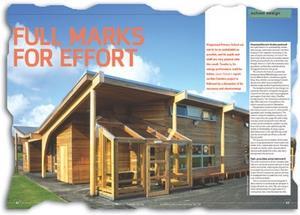I read with interest the very comprehensive report on Kingsmead Primary School by Jason Palmer (BSj 06/06).
On visiting the school many months ago, and as reported in your article, the biomass installation was commissioned on pellets, but was not operational. My colleague and I were not able, nor was it appropriate, for us to delve into the overall operation of this system, so the following comments refer only to the heating services.
Firstly, the integration of heating services assisted by solar hot water and biomass are fine as individual energy providers. To integrate them successfully into a new sustainable low-energy design presents most, if not all, the items and problems reported.
We are well respected within the biomass marketplace and have already learned that biomass has, is, and will continue to catch clients, architects and M&E consultants out. And, more importantly, the operator requires significant ongoing operational advice.
The real problem is attempting to integrate three major producers of hot water: solar, biomass and natural gas-generated hot water into a low-energy building fabric.
We know that natural gas was meant as a back-up to the biomass, but it has turned out to be the primary supplier of ‘comfortable heat'The low surface temperature radiators at 45ºC and underfloor heating are simply unsuitable for a biomass boiler, as the water entering into the covered radiator will be in the region of 70ºC - maybe even less - which in itself has to be mixed with return water for the underfloor heating. Add this to the very variable heating load requirement and I cannot see the biomass unit ever working properly on this site.
I am not privy to, nor again is it my business to audit the heat loads of the building. But someone decided the biomass boiler size, together with the natural gas boiler sizing.
I assume the boiler is operating in condensing mode. However, the building usage appears to be greater than that in an ordinary school as reported, plus there are the suggested IT loads. This was mentioned in the article as causing greater electrical consumption, but not suggested as something that could be adding to the heat gains of the building.
It worries me that such basic engineering and understanding of the subject matter has contributed to the negatives of the project. We attend many failed biomass systems - specifically the integration of these technologies into existing heating systems. This has enabled us to learn over the last few years why they fail and where they really do perform well. If you intend to use biomass in new small commercial structures, and structures which are being significantly improved upon from an energy point of view, be very careful in the design and application of these alternative heat generators.
Some designs are compensated for with the installation of a ‘buffer vessel'. Again, this solution can cause more problems than it attempts to solve at the design stage! The solar hot water panels should give a much-needed boost to the domestic hot water demand. The natural gas boiler will - and does, we hope - track domestic water temperature.
Therefore if the cost of the school and the approach taken by the design team was, as the results suggest, a fast learning curve for the net integration of renewables into a building, many lessons will have been learned in this instance. It is stated in the article that Cheshire County Council is pragmatic to date, referring to the heating performance (note I am not alluding to design). Again, that is not for me to comment on.
Risk has always been a significant aspect of the ever-changing needs of HVAC services, but PI rules these days as we adjust our understanding of the responsibility of designing such systems. The technologies are not new at all: they are different. In general, biomass systems need to work hard, they are at their best when in full duty. They can be ‘turned down' in terms of burn rate, but then you have to deal with residual heat.
A biomass boiler will not give fast turn-down rates, so a highly insulated building won't benefit from this type of heat in the main. However, if the school required hot water for a swimming pool or other major heat input, the biomass could be back on the agenda.
In our experience to date fuel and integration are the most prominent issues to deal with when attempting to accommodate a Biomass boiler. Many boilers are very fuel specific and if you stray from a manufacturers specification, you could endure months of system down time.
I trust that the design team, including the contractor, won't avoid the tough decision which may prevail in removing the biomass boiler from the site. If it cannot be fixed in what is now a major publicly acknowledged sustainable site, put it into another site that will justify its existence.
We are currently involved with biomass-powered hot water to fire an absorption chiller, together with variable heat loads (hot and cold) in a highly ventilated laboratory. We are able to sustain a case for removing over 600 kW of electric cooling (chilled water), turning down the natural gas requirement. The project will be an ESCo (Energy Services Company); the numbers stack up very well!
In conclusion, these alternative heating technologies that have been around for many years are now both in vogue and necessary (with climate change etc), but only when applied with full understanding of them and of the consequences of their use. Kingsmead is a consequence of the use of these technologies: let us learn from these applications, they provide the evidence to move forward.
Many won't bother to attempt change, but without it we cannot learn and move forward.
Bruce Boucher MInstR, MCIBSE and steering committee member of the EPG
Source
Building Sustainable Design





















No comments yet